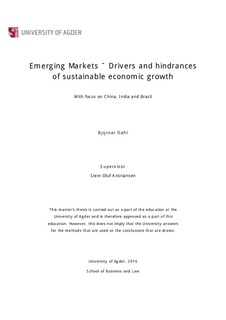| dc.contributor.author | Dahl, Bjørnar | |
| dc.date.accessioned | 2017-03-13T10:21:25Z | |
| dc.date.available | 2017-03-13T10:21:25Z | |
| dc.date.issued | 2016 | |
| dc.identifier.uri | http://hdl.handle.net/11250/2433929 | |
| dc.description | Master's thesis Business Administration BE501 - University of Agder 2016 | nb_NO |
| dc.description.abstract | The term «Emerging Market» describes a country that has some characteristics of a developed high-income economy, such as the United States, Western Europe and Japan, but does not meet the standards of a fully developed economy. The Emerging Markets are in a transitional phase marked by rapid GDP growth towards rule of law and institutional credibility. Emerging Markets describe developing countries that are not among the poorest nor of the newly industrialized countries, but countries that have the potential to become a fully developed economy (Gaeta, 2012b)
The reason that additional research on the Emerging Markets is a relevant topic is because there has been a change in the global economic landscape where the Emerging Markets have gone from being only a minor player a few decades ago to now dominating the world economic growth. Analysts are already talking about a new economic world order, with the Emerging Markets dominating the world economy in the future. This thesis look at factors that have made them grow in a quantitative data analysis for 25 different Emerging Markets as well as a case-study conducted to identify the main institutions and main drivers and hindrances for achieving sustainable economic growth in the three largest Emerging Markets; China, India and Brazil.
A great potential for future economic growth is not a guarantee for future economic success and my findings support earlier research that indicate that there is a huge difference between their potential and the reality. It would be difficult to maintain the growth rates of the last 25 years for many of the Emerging Markets and it will take a long time before most of them could be even nearly as wealthy as the countries of the developed world. A common factor for most Emerging Markets is that they struggle with institutional weakness on key areas like rule of law, governance and economic freedom. Growth and economic success is the consequence of decent economic framework conditions and to live up to their potential, institutional reforms are needed in most Emerging Markets. | nb_NO |
| dc.language.iso | eng | nb_NO |
| dc.publisher | Universitetet i Agder ; University of Agder | nb_NO |
| dc.rights | Attribution-NonCommercial-NoDerivatives 4.0 Internasjonal | * |
| dc.rights.uri | http://creativecommons.org/licenses/by-nc-nd/4.0/deed.no | * |
| dc.subject | BE501 | nb_NO |
| dc.title | Emerging Markets – Drivers and hindrances of sustainable economic growth : with focus on China, India and Brazil | nb_NO |
| dc.type | Master thesis | nb_NO |
| dc.subject.nsi | VDP::Samfunnsvitenskap: 200::Økonomi: 210::Samfunnsøkonomi: 212 | nb_NO |
| dc.source.pagenumber | VII, 105 p. | nb_NO |

